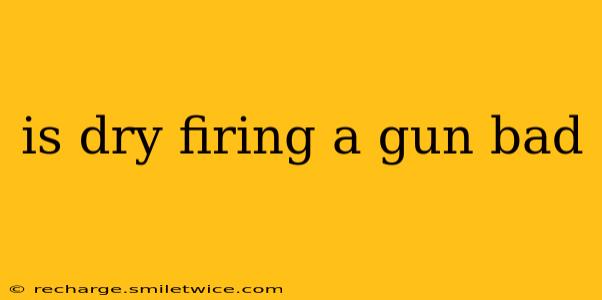Dry firing, the act of pulling the trigger of a firearm without live ammunition, is a topic sparking debate among firearm enthusiasts. While seemingly harmless, understanding the potential risks and benefits is crucial for responsible gun ownership. This comprehensive guide will explore the nuances of dry firing, addressing common concerns and providing practical advice.
What Happens When You Dry Fire a Gun?
When you dry fire a gun, the firing pin strikes the breech face. This impact, while typically minor with modern firearms, can still cause wear and tear over time. The severity depends on several factors, including the type of firearm, the materials used in its construction, and the frequency of dry firing.
Is Dry Firing Bad for My Gun?
The answer isn't a simple yes or no. For many modern firearms, especially those designed for semi-automatic operation, occasional dry firing presents minimal risk. However, older or poorly maintained firearms may be more susceptible to damage. The potential problems include:
- Firing Pin Damage: Repeated dry firing can lead to firing pin breakage or deformation, potentially affecting the firearm's reliability and safety.
- Breech Face Damage: The impact of the firing pin can also cause pitting or damage to the breech face over time, potentially affecting accuracy or reliability.
- Damage to Internal Components: In some cases, excessive dry firing can damage other internal components of the firearm.
It’s crucial to consult your firearm's manual; some manufacturers explicitly state whether dry firing is safe for their specific model.
What Types of Guns Are Safe to Dry Fire?
Most modern centerfire semi-automatic pistols and rifles are generally considered safe for occasional dry firing. However, this doesn't mean you should do so excessively. Revolvers, especially those with softer metal firing pins, are more prone to damage from dry firing.
Always check your firearm's manual before dry firing.
How Can I Dry Fire Safely?
If you choose to dry fire, following these safety precautions is essential:
- Always point the firearm in a safe direction: This is the cardinal rule of firearm safety, applying even more so during dry firing.
- Use a snap cap: Snap caps are specifically designed to protect the firearm's firing pin and breech face during dry firing. They absorb the impact of the firing pin, greatly reducing wear and tear.
- Avoid excessive dry firing: Limit your dry firing sessions to prevent cumulative damage.
- Inspect your firearm regularly: After each dry firing session, visually inspect your firearm for any signs of damage.
What are snap caps and why should I use them?
Snap caps are essentially dummy cartridges designed to absorb the impact of the firing pin during dry firing. They protect your firearm from potential damage and are a crucial tool for safe dry firing practices.
How often is it too often to dry fire my gun?
There's no magic number. A few sessions a month are unlikely to cause significant damage to a modern, well-maintained firearm using snap caps. However, excessive dry firing, even with snap caps, should be avoided. Focus on quality practice rather than quantity.
What are some alternatives to dry firing?
Consider using laser training devices or realistic airsoft replicas as alternatives for training. These methods allow you to practice your trigger control and draw without any risk to your firearm.
Conclusion: Responsible Dry Firing Practices
Dry firing can be a valuable tool for improving shooting skills, but it's crucial to practice responsibly. Always prioritize safety, use snap caps, and check your firearm's manual before engaging in dry firing. By adhering to these guidelines, you can reap the benefits of dry firing without risking damage to your firearm. Remember, the responsibility of safe gun handling rests with you.
